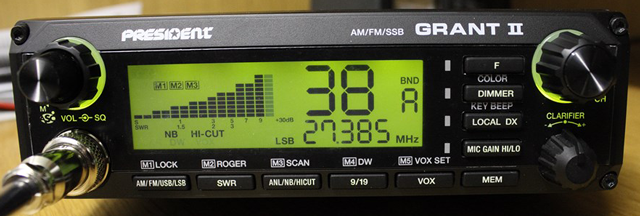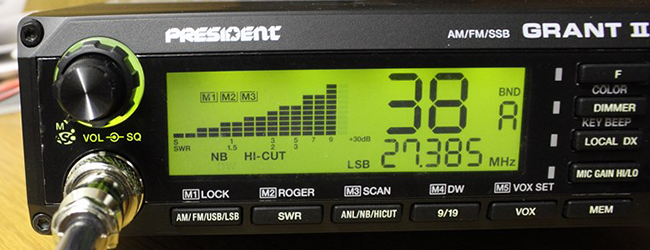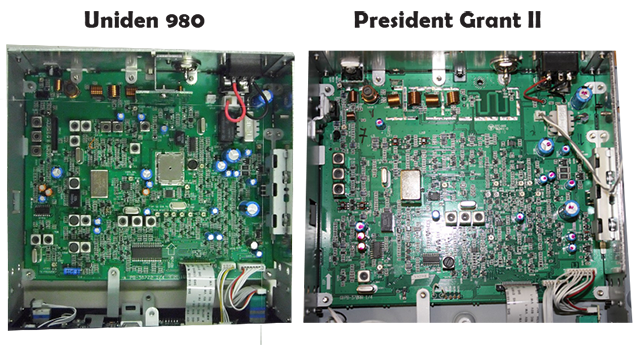President Grant II AM/FM/SSB CB Radio Overview

We’ve been anxiously awaiting the release of the President Lincoln II over the last year but little did we know that President was planning to release two SSB radios in 2014. Yes, the long dry spell is over and to kick things off we’re going to be doing a review of the new President Grant II AM/FM/SSB 10/11 meter radio from President.
For North American consumers the release of these radios is going to be a little bittersweet; yes the radios are awesome, yes they are now available, but if you want one you’re going to have to purchase from a dealer in Europe and have them ship it over. Are the radios worth shipping over? You’ll have to make that decision on your own.
UNBOXING
The President Grant II box is small (same size box as the Uniden 980) and inside you’ll find the normal collection of gear – Radio, Microphone, Power Cord, Mounting Bracket/Hardware, and Manual. You’ll notice the size immediately, it’s a small compact radio and uses the same case as the Uniden 980 (Dimensions – 7 1/4 W x 2 1/4 H x 7 1/2 D). Instead of the shiny chrome bezel the President Grant II opted for a flat black look to match the cases. While the case of the radio is similiar to the Uniden and there are some design similarities, the board is different and the President Grant II really does act like a completely different radio.
CONTROLS AND LAYOUT
Starting on the left hand side of the radio you’ll find the volume/squelch knobs. These are set up in the inside/outside pot configuration with the volume knob also controling the on/off function for the radio. The squelch knob includes an ASC setting in the full counter-clockwise position that will turn on that function in AM/FM modes.
The microphone connector is a six pin connector and there is a “hot” pin so be careful in your microphone wiring if you decide to hook up a different microphone. The included microphone is medium size (not full size) and includes up/down channel selectors on the top.

Moving to the buttons along the bottom of the radio which run underneath the display, you’ll find that these are dual purpose buttons. A short press is the standard function while holding the button in for 2-3 seconds enables the secondary function.

The first button is your mode selector, pushing this button multiple times will cycle through the AM/FM/USB/LSB modes. The secondary funtion enables a key lock which locks all controls on the radio. The next button is the SWR/RF button that lets you toggle between and RF meter or SWR meter on the display. The secondary function enables your roger beep (I should mention that the President roger beep is very distinct, simple, and not very annoying). The next button toggles between NB (Noiseblank), ANL (Automatic Noise Limiting), and High-cut (reduces high end hiss). All three can be enabled in AM and FM modes but only the NB and High-cut can be enable in SSB modes. The secondary function is the scan feature on this radio.
Next button is a channel 9/19 quick selection button to take you to the emergency or trucker channel. The secondary function is the dual watch function (the dual watch toggles between a chosen channel and either channel 9 or 19). The VOX button is next which enables the voice-operated switch (this feature allows you to key the radio using your voice only, hands free operation). The secondary function opens up the VOX settings menu.
The last button along the bottom is the MEM (memory) button and it does not have a secondary feature.
If you’re not well versed in the functions I’ve mentioned you can read more about them in the President Grant II manual (easier than me taking the time to explain them here) or watch my video at the end of the article which shows the functions in action.
Moving along to the vertical buttons that are to the right of the display – the F button is used to change bands (frequency banks) when the radio has been modified for additional frequencies. The next button is the dimmer switch (this radio has a low and bright option). The secondary function of this button is to change the color (the radio has two colors, orange and green). Below is the Local/DX button which is basically a simple RF gain function since you’ll notice this radio doesn’t have a RF gain knob. Secondary function is the on/off of the key beeps (if you don’t turn this off everytime you press a button it beeps – this was one of the annoying things about the Uniden 980 but on this radio you can turn it off). Last up is the Mic Gain Hi/Lo button.

To the right of the buttons are two knobs, on top is a channel changing knob and underneath is a clarifier.
The back of the radio doesn’t have a heatsink due to the single final so the front to back length of the radio is shorter than many other exports. It has a VOX input and external speaker plug along with the standard 3 pin power cord. The radio is made in Vietnam.

FUNCTIONS THAT NEED TO BE MENTIONED
You can read through the manual or watch my video to learn more about how the functions work, but there are couple that I wanted to discuss as I think they make this radio stand out.
MEMORY FUNCTION – This radio has 5 locations where you can store commonly used or favorite frequencies for quick reference. It memorizes both the frequency and the mode. The scan feature also has a mode where it will scan only the memory frequencies.
Taking this one step further – you can save frequencies from any of the A-J bands in the memory frequencies. This means that you can have 27.385 LSB in Memory 1 location and 28.425 USB in Memory 2 location which allows you to quickly jump from 11 to 10 meters and vice-versa. Even cooler is the fact that once in the band you can then just change the channel and continue to flip through the frequencies in that band. This makes using this radio for freeband and CB really handy.
HI-CUT – This radio has perhaps one of the best Hi-Cut functions I’ve ever seen on a CB or Export radio. When depressed it will cut back the signal somewhat but you are rewarded with clear and quiet listening and the signals that do come through still sound natural and un-distorted. If I could stick this feature on every CB radio I owned believe my I would, it’s that cool. For really quiet far-off stations, it may make them a little hard to hear but for stations giving a S3 signal or stronger it really makes for nice listening.
VOX – While it’s probably not something you are used to using, the VOX feature works very well on this radio and allows you to lay the microphone on the desk, sit back and just talk to key the radio. Once you stop talking the radio has a short delay (which you can adjust the length) and then will unkey and go into receive mode. You can adjust the sensitivity and also the anti-vox which helps prevent stations you hear in the receive from keying the radio accidently. There is also a VOX input plug in the back to use a different style of VOX microphone.
DISPLAY
The display on this radio is clear and easy to read. While it has a digital meter for S/RF, the increments are individual so you can get a pretty good idea of signal strength. The display holds up well in sunlight, much better than some of the older screens we used to see on the Deltaforce type radios. The frequency display is easy to read and all of the functions have abbreviations that will display when they are active, making it easy to know if a function is on/off.
RECEIVE
Of all the talking points for this radio I have to say the receive is really what makes it stand apart. It is leaps and bounds better than most of the exports on the market. The sound quality is excellent and stations sound very crisp and clear. I also found that the radio experienced a little less intereference in city areas compared to the CRE 8900 and Uniden 980 that I recently tested. Tuning in stations was easy with the clarifier, and I found that sound quality was great in all modes, especially SSB.
TRANSMIT
This is a single final radio and not a very powerful one at that. Your Galaxy 959 or 979 will most likely swing to higher output numbers in all modes so if you’re looking for a single final radio with 20 watts output this is not it. The radio will key about 4 watts on AM and swing to around 12-14 watts once the modulation has been adjusted upwards. SSB output is around 15 watts and FM output is around 4-5 watts depending on how you set it up. The nice thing is that you can set the AM deadkey around 1.5-2 watts and have the radio swing around 10 watts which would work well for an amplifier such as the KL203.
AM & FM TRANSMITTED AUDIO
Compared the the recent Anytone and CRE type models this radio has better quality on AM and FM but may not be as loud. The sound is very natural and strong. It still isn’t going to be in the Magnum or Galaxy type AM arena but that can also be a good thing and the audio comes through very clear and clean.
A great example of this audio can be heard in the video below provided by a radio reviewer overseas (m0ogy) –
SSB TRANSMITTED AUDIO
SSB audio on the President Grant II is clean, clear, and crisp. It’s not overpowering but it does have enough of a punch to be heard. If you like the sound of Cobra 2000’s or President Washingtons with Turner +3 desk microphones then you may not like the on-air sound of this radio. Why is that? The SSB audio on this radio sounds much more like current ham radio rigs. It does have a slightly pinched sound with the stock microphone and overall I would discribe the audio as having a “processed” feel to it. Going to a desk mike got rid of the pinched sound, but the audio still does sound processed. Now this isn’t necessarily a bad thing as the audio levels are excellent and there is very little drop off on any particular syllable making it great for SSB use. I think some of the old school guys won’t like the sound but for everyone else you’ll find this radio is very understandable on the air. I got excellent reports and stations I talked to said the audio levels and sound was great.
FREQUENCY STABILITY
This is where the radio shares some commonality with the Uniden 980, it is rock solid on frequency even after spending the night in the truck in 28F tempatures. I didn’t experience any warm up issues, I just turned it on and it was ready to go. I didn’t touch the clarifier at all in 3 days of testing except to tune in one station that was pretty far off frequency. The clarifier is not unlocked from the factory and will only effect RX.
EXPORT MODE
To convert this radio for additional frequencies is fairly easy (see my video below for details). After performing the modification you’ll have the following bands available –
A 26.965 – 27.405
B 27.415 – 27.855
C 26.515 – 26.955
D 27.865 – 28.305
E 26.065 – 26.505
F 28.315 – 28.755
G 25.615 – 26.055
H 28.765 – 29.205
I 29.215 – 29.655
j 29.655 – 30.105
The modification also unlocks the ability to change the last digit from a 5 to a 0. Something useful for freeband and ham radio bands. The radio does not have the ability to tune in 1 kHz steps which would have been a nice feature on this radio, but I think since the new Lincoln II is going to offer split modes and 1 kHz tuning steps President is trying to tier their radio line a bit and make a clear distinction between the President Grant II and the additional features added to the President Lincoln II. I think the more serious operators who also are looking for a radio to use on ham radio frequencies and perhaps even CW use will be looking towards the Lincoln II.
Tuning locations are marked on the board (see my video) and adjustments are fairly easy but be aware that the pots rotate continuously so it’s not just a matter of cranking them all the way up. Additionally, adjusting the AMC pot effects both AM and SSB in this radio. The images below show the differences in the Uniden 980 and Grant II boards.

FINAL THOUGHTS
When the Uniden 980 came out we all got excited as we thought it might be modifiable for extra frequencies, but alas it is locked up tight and even though it had good performance as a CB radio, it didn’t check off the boxes for freeband users. The President Grant II picks up all the good from the Uniden 980 and then takes things to a higher level. It has better receive, better audio, better swing, extra channels, and extra functions such as ASC, VOX, Roger Beep, and Hi-Cut. This is the new breed of export radio and unlike the early Alpha AM-1000 or Anytone models, the factories and designers seems to have finally gotten things figured out. The build quality is excellent, they’ve reduced the size of the radios, and the functions and features are much easier to use than previous models.
The radio doesn’t put out a whole lot of wattage so a small amplifier definitely would be on my add list and the stock microphone can sound a bit tinny so adding a nice power microphone will also help out. The receive really blew me away and while the transmitted audio does sound a bit processed the on-air reports were excellent with everyone saying it sounded really good. As we’ve only had the radio for a short time we can only hope it will hold up over time and if we run into any problems we will post updates to this article.
As mentioned before this is only available in Europe and it isn’t cheap, but it’s a solid radio that packs a lot of features into a small footprint. The real decision for most buyers will be, do they opt for the Grant II or do should they save up a couple of more pennies for the Lincoln II (hitting shelves in Feb 2014 I believe)? I really don’t think you can go wrong with either radio and I’m happy to see manufactuers contining to support our hobby. It will be interesting to see how Ranger, Magnum, and Galaxy respond to these new models – the bar has definitely been raised.
